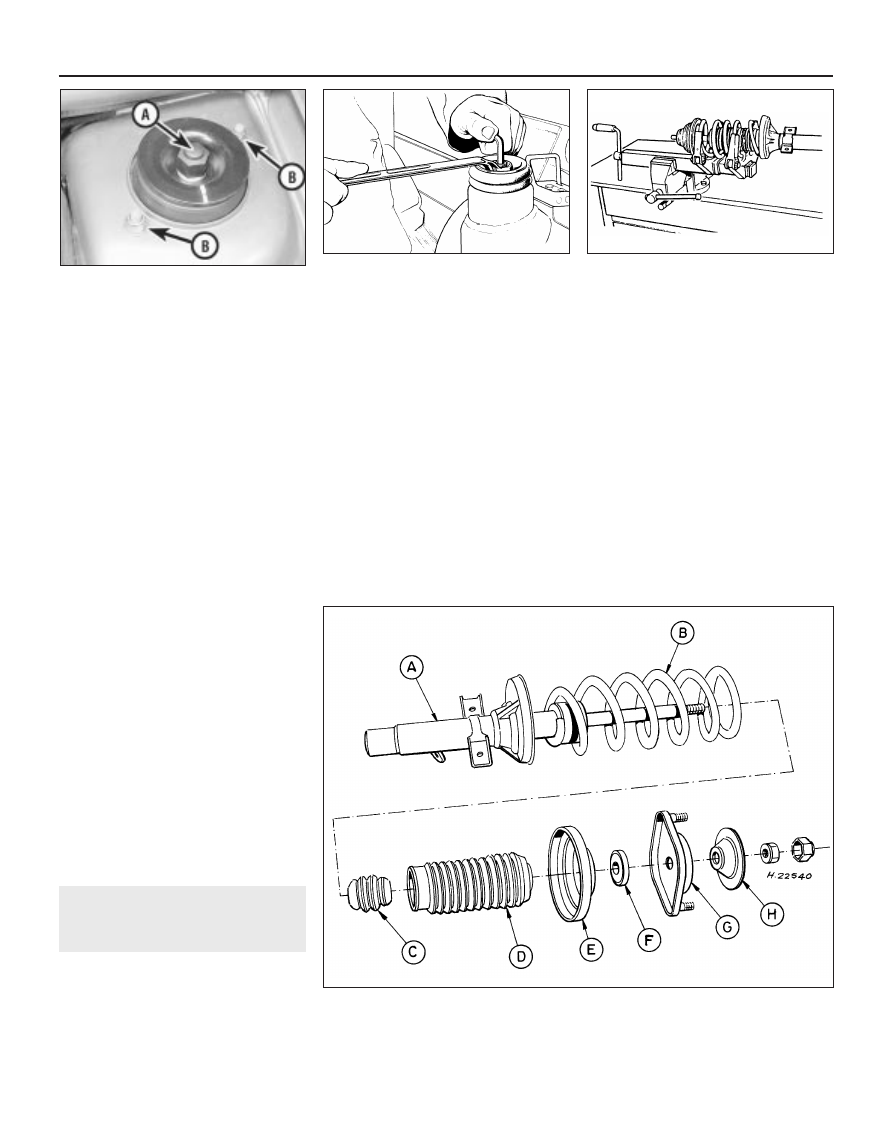Ford Orion. Manual - part 52

2 Open and support the bonnet. Prise free
the protective cap from the strut upper
retaining nut, then loosen off, but do not
remove, the central retaining nut. As the nut is
loosened off, hold the strut piston rod with an
Allen key to prevent the rod from turning as
the nut is loosened (see illustrations).
3 Detach the front brake hose from the
support bracket on the strut.
4 Where applicable, unbolt and detach the
anti-roll bar link rod from the suspension strut.
5 Unscrew and remove the strut-to-spindle
carrier clamp bolt.
6 Note the direction of fitting, then unscrew
and remove the lower arm balljoint-to-spindle
carrier clamp bolt. Prise the joint open using a
large flat-bladed tool, and detach the balljoint
from the spindle carrier. Take care not to
damage the balljoint seal during the
separation procedures.
7 Prise open the spindle carrier-to-strut joint,
and separate the carrier from the strut. Tap
the carrier downwards using a soft-faced
hammer to release it from the strut if
necessary.
8 Support the weight of the strut underneath,
and unscrew the two nuts securing it to the
turret at the top. Lower the strut and remove it
from the vehicle.
Refitting
9 Refitting is a reversal of removal. Tighten all
the retaining bolts to the specified torque.
When reconnecting the suspension lower arm
balljoint to the spindle carrier, ensure that the
clamp bolt is fully engaged in the locating
groove, and prevent the bolt from turning as
the nut is tightened.
7
Front suspension strut -
dismantling, examination and
reassembly
4
Note: Before attempting to dismantle the front
suspension strut, a tool to hold the coil spring
in compression must be obtained. The Ford
tool is shown in the accompanying
illustrations, however careful use of
conventional coil spring compressors will
prove satisfactory.
Dismantling
1 With the strut removed from the vehicle,
clean away all external dirt, then mount it
upright in a vice.
2 Fit the spring compressor tool (ensuring
that it is fully engaged) and compress the coil
spring until all tension is relieved from the
upper mounting (see illustration).
3 Hold the strut piston with an Allen key, and
unscrew the nut with a ring spanner.
4 Withdraw the cup, retainer (top mounting),
the bearing and upper spring seat, followed
by the gaiter and the bump stop (see
illustration).
5 The suspension strut and coil spring can now
be separated. If a new coil spring or strut is to
be fitted, the original coil spring must be
released from the compressor. If it is to be re-
used, the coil spring can be left in compression.
Examination
6 With the strut assembly now completely
dismantled, examine all the components for
wear, damage or deformation, and check the
bearing for smoothness of operation. Renew
any of the components as necessary.
7 Examine the strut for signs of fluid leakage.
Check the strut piston for signs of pitting
along its entire length, and check the strut
body for signs of damage or elongation of the
mounting bolt holes. Test the operation of the
strut, holding it in an upright position, by
moving the piston through a full stroke, and
then through short strokes of 50 to 100 mm.
In both cases, the resistance felt should be
smooth and continuous. If the resistance is
jerky, or uneven, or if there is any visible sign
of wear or damage to the strut, renewal is
necessary.
10•6 Suspension and steering systems
7.4 Front suspension strut components
7.2 Ford special tool in use to compress
the front suspension strut coil spring
6.2B Method to use when loosening off
the strut upper mounting
6.2A Front suspension strut upper
mounting showing the protective cap over
retaining nut (A) and the strut-to-body
mounting nuts (B)
A
Strut
B Spring
C Bump stop
D Gaiter
E
Upper spring seat
F
Bearing
G Top mounting retainer
H Top mounting cup